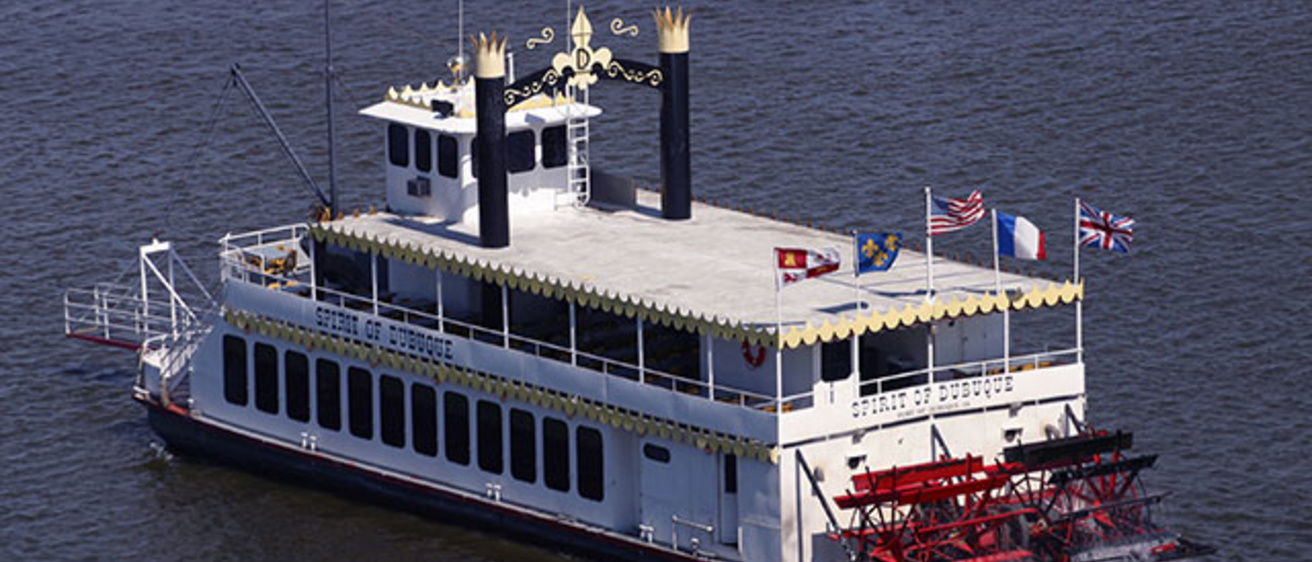Editor's note: The University of Iowa offers lots to do throughout the year, from arts performances to readings, and lectures to recreation. But sometimes faculty, staff, and students want to explore areas beyond campus. So University Communication and Marketing is publishing a series of "daytripper" stories this summer, pointing to fun, interesting, and uniquely Midwestern destinations within a day's drive of Iowa City. Other stories in the series can be found here.
It’s an easy 90-minute drive from Iowa City to Dubuque, but once you get there, so many more interesting modes of transportation abound.
You can tour the hilly city by TRIKKE, a three-wheeled, stand-up, electric-powered vehicle.
Or fly over the tree tops on a zip line.
Head down to the Port of Dubuque and cruise the river by paddle-wheel boat.

Going (straight) up!
Or for a truly unique ride, make your way to Cable Car Square and climb aboard the Fenelon Place Elevator, the world's shortest, steepest scenic railway. It runs just 296 feet in length, while carrying passengers up 189 feet from Fourth Street to Fenelon Place.
First built in 1882, the elevator’s original purpose was to facilitate the naptime of a local banker. Driving his horse and buggy up the steep bluff from the bank to his home two and a half blocks away took 30 minutes each way, which didn’t leave time to eat and nap during his 90-minute lunch break.
At the banker’s request, local engineer designed and built a one-car cable modeled after those in the Alps, with a plain wood building, that housed a coal-fired steam engine boiler and winch.
Unfortunately, that coal fire led to the elevator’s destruction two years later, when it flared up overnight. After he rebuilt, the banker opened the elevator to the public at five cents a ride.
These days it costs $3 for a round-trip and the elevator is no longer powered by coal. Two (funicular) counterbalanced cars are pulled up and down the hill on steel cables from 8 a.m. to 10 p.m. daily from April through November.
From the top you can see for miles—to Wisconsin and Illinois, towering Dubuque church steeples, the Port of Dubuque and Mississippi River.
Up close on the river
After this 200-foot view, head back down the elevator and over to the National Mississippi River Museum and Aquarium for a closer look at the history, ecology, and economy of America’s great river.
In truth, you could spend your entire day at this expansive museum, but “Drive to Dubuque; go to the museum” doesn’t make a very interesting article.
The aquarium features both fresh- and salt-water tanks (the river does meet the sea after all), which are home to a host of creatures including catfish, sturgeon, turtles, alligators, sharks, rays, and more. An adjacent hands-on area offers a touch tank with freshwater mussels, snails, and crawfish, which surprise and delight with their backward swimming.
An interactive water table demonstrates the power of floods, and a kids’ area features a crawl-through beaver lodge and a separate water table that demonstrates the function of the river’s extensive lock-and-dam system.
The museum offers extensive history, culture, and artifacts of the people who have lived along America’s great rivers. You can also try your hand at piloting a barge and feed logs into a steamship furnace.
Stepping outside, visitors can experience the natural river habitat on a riverfront trail, that leads to several river boats open for exploration. The largest of these is the William M. Black, a 1934 dredge boat used on the Missouri River during World War II. The engine room, pilothouse and decks are open for touring, and if you’re really ambitious, you can even arrange in advance to spend the night.
A walk in the park
By now you should be getting hungry. Grab your cooler or pick up some carry-out and head to the Dubuque Arboretum and Botanical Gardens for a picnic. This lovely park offers 52 acres of paths, gardens, and plenty of picnic tables. There’s also a playground for kids with energy to burn.
Stop in the visitors’ center for a map and then enjoy a leisurely stroll through 17 different garden areas including annuals and perennials, herbs and hostas, peonies and prairie wildflowers, and more. While you’re in the visitors’ center, you can also purchase a packet of fish food for $1 to keep in you pocket until you reach the koi pond and waterfall garden.
The park remains free to the public because 375 area residents volunteer to staff and maintain it, making it the only arboretum in the country without paid staff. If you like what you see and want to support this group, donations are accepted in the visitors’ center.
Dining on history
If you skipped the picnic, you might consider heading up the Great River Road to Breitbach’s Country Dining in Balltown for dinner before returning to Iowa City. Iowa’s oldest food and drinking establishment was opened in 1852 by federal permit issued from President Millard Fillmore.
Jacob Breitbach, the great-great grandfather of the present owner, worked for the original owner and purchased the tavern in 1862. Six generations of Breitbachs have kept the tradition alive, even through the total destruction of the building by fire twice in 10 months in 2007-08. Award-winning, home style cooking supports a menu full of items all prepared fresh daily.
